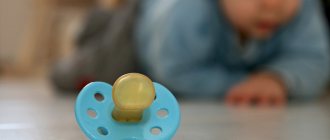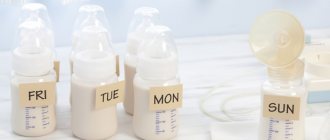Not all babies agree to be fed from a bottle the first time. But often the mother simply has no choice. In order to teach your child to drink from a bottle, you will need ingenuity and patience. And if you use some tips, the problem will be solved quickly and calmly, both for you and for the child himself.
Unfortunately, a mother cannot always attach her baby to her breast. Sometimes this is prevented by her illness or forced separation from the child for a long time, and there are also frequent cases when breastfeeding is contraindicated.
Also, the mother can give the child herbal tea, water, and baby formula from a bottle. However, the main reason for accustoming a baby to feeding with a bottle is the transition to another type of feeding - mixed or artificial.
Reasons for turning to the bottle
Usually, breast milk is enough for a newborn baby who is breastfed. But in certain cases, it is still necessary to accustom a child to a bottle.
The most common reasons for such situations are presented below:
- Children under 4 months often suffer from colic and abdominal pain due to imperfections in the digestive system. In this case, special herbal decoctions come to the rescue - for example, dill water. It is also given in a bottle.
- The need to supplement the baby's food appears in the spring and summer due to dry air in the room or high temperature. However, doctors are convinced that it is not necessary to specifically give water until 4 or 6 months, even in these cases. The child will receive the necessary liquid with milk.
- Switching to a bottle “surrogate” is possible if the mother or baby is ill. Sometimes a nursing woman is forced to take medications that are contraindicated during lactation, then the baby temporarily feeds on formula. Due to lactase deficiency, infants also need to be switched to special baby food.
- Not all nursing mothers can sit quietly on maternity leave. For various reasons, it ends prematurely when the child turns, for example, 4 months. There are also frequent cases when women are absent for a long time, and the baby remains with relatives.
The most common reason for turning to a bottle is a lack of breast milk or the baby is premature.
In the first case, they resort to artificial formulas, in the second, they often use expressed breast milk. But it’s one thing when the habit of eating from a bottle has been formed since birth. But if previously the baby sucked exclusively on the mother’s breast, the process of accustoming to a different “container” can take up to 4 weeks or more.
Other options
All or nothing is the only decision for most mothers.
Many working mothers prefer to wean their baby gradually; the child can be bottle-fed during the day by a teacher in the garden or by a grandmother when she is at home. There are two strategies:
- The first strategy combines breastfeeding when the mother is near the baby, and in her absence the teacher uses a combined formula. By feeding your baby before leaving for work, you thereby ensure yourself the prevention of breast engorgement. On weekends, if the milk level is insufficient, you can mix milk with the missing volume of the formula.
- Other moms express milk at work, so the caregiver can give the milk to the baby in a bottle. The more often you pump, the more often your baby can drink milk, about three 15-minute feedings a day.
Back to contents
Is training necessary?
Before using the advice of specialists and experienced parents, it is necessary to thoroughly understand the current situation. And the first step that a mother must take is to analyze the goals for which she plans to teach her baby a bottle.
Read a very interesting article from a pediatrician about the benefits of breast milk for the full development of a newborn baby.
Useful information from a psychologist regarding a common problem, how to wean a child off a pacifier.
For example, some women introduce their children to this device to make it easier to take medications. However, in this case there is obvious inexpediency of attempts.
To give your child a liquid drug, you can use several alternative options:
- beaker;
- needleless syringe;
- teaspoon.
Of course, the baby will not like such manipulations, but for short-term use of medications such options are more preferable than fully accustoming the baby to a bottle.
If the situation really does not suggest any other way out than the final refusal of the breast, then artificial feeding with the help of a nipple remains the only alternative.
Doctors recommend delaying introducing a child to a bottle as much as possible, if possible. It is worth understanding that no formula can fully replace breast milk.
Pay more attention
The closeness that is present during breastfeeding is the missing ingredient for baby and mom after breastfeeding stops.
Is it possible to feed a baby with formula milk?
Be sure that during the weaning process, you need to pay more attention to your baby.
You need to replace the intimacy of breastfeeding with something else that will make up for the emotional losses - you can hug your baby, read to him, or even play with him on the floor.
And don't forget how helpful a husband can be. Dad can put the baby to bed and wake him up in the morning, thereby reducing the mother's stress at this time.
Back to contents
Why won't the baby take the bottle?
To accustom your baby to replacing his mother's breast, you need to understand why he is against receiving formula from a bottle. There may be several reasons for this:
- The most obvious reason is that the baby is simply not hungry. For a small child, milk or formula is enough, but when he gets a little older (after 4 months) and begins to actively move, he will get used to the bottle sooner. Thus, the smaller the baby, the more difficult it is to wean him to a breast replacement.
- Also, the baby may not be satisfied with the contents of the bottle. Babies who have previously tried breast milk do not always quickly switch to nutritional formulas, each of which has its own taste. Mom will have to change several product options before finding the optimal mixture.
- The baby is extremely picky in terms of food temperature due to the high sensitivity of the oral mucosa. If your child does not drink from the bottle, the formula may feel too cold or scalding. The optimal temperature is 37 degrees, the same as for breast milk.
- Also, the baby may react negatively to the feeding device itself. It is only the mother who thinks that the bottle is ideal, but the child is not satisfied, for example, with the width of the hole in the nipple, which affects the baby’s absorption rate of food, the smell and taste of the silicone product, and the shape of the container.
- A child who was introduced to a bottle at 4 or 5 months may not immediately understand the purpose of this tool. As a result, instead of receiving nutrient liquid from the container, it begins to play, turning the useful device into a gaming accessory.
Sometimes the reason for unsuccessful training is a psychological factor. For example, a baby receives formula for the first time in a hospital or after an emergency separation from his mother. In this case, he begins to associate negative emotions with the bottle and the mixture.
For what reasons might a child refuse a bottle?
First of all, parents of a newborn baby must understand that it is unnatural for a baby to drink from a bottle, because nature intended that an infant should feed exclusively on mother’s milk. And the baby subconsciously refuses the bottle, preferring the mother’s breast, because the process of breastfeeding is not only a feeding period, but also an opportunity for close contact with the mother.
The reasons for a baby refusing a bottle may also include the following:
The child does not feel hungry. Many parents do not take this reason into account at all. Meanwhile, you need to understand that the baby may simply not be properly hungry yet. The older the child gets, and the more energy he expends, the more often and more he will eat. It often happens that in the first months of life, it is very difficult to feed a baby from a bottle, while when closer to six months of age, the child happily drinks from a bottle on his own.
The child does not like the taste of artificial formula. The mixture offered by different manufacturing companies can differ significantly not only in quality, but also in taste. One mixture is sweeter, the other is blander. Before giving the formula to the baby, the mother should definitely try it herself. If the reason for a baby’s refusal to take a bottle lies precisely in the taste of the artificial formula, then you need to offer the child a milk formula from another manufacturer.
The drink offered is too hot or cold. All food offered to a newborn baby should be warm, like mother's milk (36-37 degrees). It is impossible to give the baby cold or hot food: this can not only seriously harm the baby’s health, but also ensure that the baby completely refuses the bottle and will be capricious and cry at the sight of it.
It is uncomfortable for the baby to drink from a bottle. In this case, it means that the bottle is inconvenient or the nipple is too tight. When choosing a nipple, you should choose a soft nipple, with a medium-sized hole, so that it is easy for the baby to get milk (formula), but at the same time it does not flow in an endless stream (so that the baby does not choke). The shape of the nipple and quality play an important role. Cheap products, as a rule, are rarely of good quality, they smell like rubber, and the shape of the product is not convenient for a newborn baby. Therefore, you need to carefully choose a pacifier for an artificial baby. The best option is to purchase several pacifiers at once, so that when the child first refuses to drink, you can immediately offer him another pacifier, and not run headlong to the pharmacy for a new pacifier.
Uncomfortable position or environment for the baby. In addition, it is important to hold your baby in a comfortable position during bottle feeding. Unfortunately, the position that is comfortable for the mother during feeding is not always also comfortable for the baby. Sometimes you have to try all the available options before the mother understands in what position it is convenient for her baby to eat. It is convenient for some children to eat while lying down, for others - half-sitting. As a rule, even when feeding from a bottle, the baby should be held in your arms, simulating breastfeeding.
Rules for a successful transition
In order to transition from breast to bottle without any problems, the mother needs to be patient and take a responsible approach to the child’s acquisition of this skill.
You may need a certain trick. If a baby, accustomed to suckling from the mother's breast, turns away from the bottle with the formula, you need to express your milk into the container.
In addition, introduction to this useful device must be unobtrusive. First, you can show the bottle to the baby and let him hold it, but it is important to create an understanding that this item is not a toy.
And only then, when the child gets hungry, you should run the silicone tip over the cheek or lips. The activated sucking reflex will “force” the baby to take the pacifier into his mouth.
There is also no need to rush, completely switching the baby to formula in one day. At first, it is better to give food in a bottle no more than twice a day. As soon as the baby gets used to the container, the frequency of artificial feedings is gradually increased.
If the child is categorically against this particular bottle, try offering different nipple options - experiment with shape, material, hole size. This will allow you to select the most optimal silicone tip.
Another important rule that answers the question of how to accustom a child to formula involves choosing the right time for feeding. The bottle should be offered to a hungry child. But if the baby is too hungry, he will begin to demand exclusively his mother’s breast.
The baby will more likely get used to the plastic container if you do not force him to drink formula or water. If the mother, wanting a speedy result, screams and gets nervous, the baby will begin to be afraid of the bottle and, in the end, will generally refuse to eat from this item.
Baby won't take the bottle - what to do?
When switching to a new type of feeding, a paradox often arises: it is high time for the baby to be full, but the child does not take a bottle, demanding to be fed with “natural nutrition.” How to speed up the transition process?
Pacifier
If your baby is already familiar with such a pacifier, then the process will be much easier. There is no need to be afraid that a pacifier will ruin your child’s bite: the vast majority of children are born with an NOT ideal structure of the jaw system! And sucking even an “empty” nipple improves the digestion process, serves for the further development of all body systems, and also gives the baby a feeling of calm and satisfaction during the first few months of tender infancy.
To get used to a bottle faster, you can use a pacifier, especially one with a bright design.
Hunger
You should not expect that the baby’s natural need for food - hunger - will solve all the problems at once. The baby may not be hungry at all when you decide to conduct the first experiment. The baby may be tired at this moment and wants to sleep more than eat, so he is not going to take your bottle!
Hot and cold
The milk that the baby receives from the breast is at the mother's ideal body temperature. You need to make sure that the formula or donor milk that you offer your child has the same temperature - 36-370. This is easy to check: place the bottle on your own cheek, closer to your neck, or the crook of your elbow. If you don’t feel anything, the temperature is exactly right!
Taste
Of all the sensations that Mother Nature bestows on a newborn from the first minutes of his life (smell, hearing, sight), taste comes first. This is one of the protective factors, as important for the survival of the baby as the sucking reflex.
We can easily “pour” medicine, tea, water into the baby using a spoon or pipette, we can even force him to swallow it through simple manipulations. But even the magician Makarenko cannot force him to drink through a pacifier a liquid that he has determined is harmful to himself!
You will have to stock up on several types of mixtures and gradually offer them to the “daw” for testing. There are times when a wonderful child refuses all lucrative offers. Then consult your pediatrician. You may be offered the option of donor milk or the option of diluted goat or cow milk. Don't experiment with whole milk yourself!
The child must want to eat the contents of the bottle, otherwise the training process may be delayed
Useful tips
If the first acquaintance was successful and you need to consolidate the positive result, you should use several useful tips:
- Is your baby fussy when bottle feeding? The mixture may be coming in very slowly. In this case, you can enlarge the hole in the tip, but it is important not to overdo it, otherwise the baby will choke;
- as mentioned above, you should choose the most optimal shape of the nipple. It is also important to take several of them, as they tend to “fail” at the most inopportune moment;
- the temperature of the silicone tip differs from the temperature of the mother's breast, so the nipple (as well as the bottle) should be slightly warmed before feeding under running warm water. When teething, on the contrary, the pacifier needs to be cooled to soothe the gums;
- It is strictly forbidden to leave a child alone with a bottle, especially if he is under four months old and constantly lies down. In such a situation, the baby may simply choke;
- if the transition to feeding from a plastic container was temporary, you need to give the bottle with the formula to the child not on your favorite sofa (where breastfeeding took place) and in a completely different position.
- Of course, you need to remember to take extra care of your feeding equipment. Bottles must be regularly sterilized and washed with a brush, but without cleaning agents.
Thus, properly accustoming a baby to a bottle must take into account all factors: the first meeting, the psychological mood of all participants in the process, the shape of the nipple, the temperature of the mixture and other conditions.
The recommendations described above will help every mother achieve positive results. A little patience and effort - and the child will eat from a bottle without much prodding, to the delight of his parents and grandmothers.
Recommendations
If your child is breastfed, and you need a bottle solely for taking medicine or supplementary feeding, then it is not at all necessary to accustom your baby to it. Moreover, many pediatricians and pediatric dentists speak out about the negative impact of pacifiers and bottles on the formation of bite. Therefore, in this case, you can use a beaker, spoon or syringe without a needle. And if you can’t do without a bottle, then you have to try.
What to do to get your baby to start drinking from a bottle:
- act gradually
To introduce your baby to a new object, let him examine the bottle and hold it in his hands when he is not yet hungry. Introduce bottle feeding gradually, starting with once a day and gradually increasing the number of feedings. If you go to work, you need to teach your child to drink from a bottle no later than two weeks before this event. When offering a drink, squeeze a drop of milk from the nipple into your baby's mouth.
- imitate breastfeeding
Mother's breast is a source of maternal care, comfort and protection. Therefore, if it is convenient for the child himself, drinking from a bottle should be associated with breastfeeding. While feeding, hold him as you would while breastfeeding. The nipple of the bottle should be at nipple level. It is most convenient to place the baby on your lap and, holding him with one hand, hold the bottle with the other.
- experiment
If you are faced with a newborn’s firm refusal to take a bottle, it makes sense to offer him a bottle with different nipples, the range of which is wide today. Let your baby try silicone, latex, standard round, flat, and orthodontic pacifiers that resemble a woman's nipple. Sometimes, surprising parents, children choose the cheapest regular pacifier. You can also offer a bottle, slightly changing the temperature of the liquid. After all, some babies love warm drinks, while others prefer cool ones.
- choose the optimal time
Naturally, there is no point in offering a bottle to a well-fed child. But you shouldn’t wait until he’s very hungry either. A hungry baby will be nervous and capricious. And, as you understand, he is unlikely to want to study a new means of feeding, but will demand to be fed as before.
- ask for help
The presence of the mother when trying to feed the baby from a bottle does not always contribute to success, especially if he is still breastfeeding. Therefore, ask a grandmother, nanny, or other woman who has experience caring for small children to help. Fathers of children are not always able to withstand children's whims. Therefore, at the initial stage of bottle training, it is better not to involve dad.
- be unobtrusive and patient
In such a responsible process as bottle training, the main thing is care and patience. At the very first feeding, try to gently move the pacifier along the baby's lips. It is possible that, following instinct, he himself will take her in his mouth, as he would take the nipple of a breast. Make sure that the nipple is taken completely. If the child does not show initiative, carefully place the pacifier in his mouth.
Read also: How much breast milk or formula should a newborn eat per day in the first days of life
Once your efforts bear fruit and your baby agrees to take drinks and food from a bottle, remember to maintain hygiene and safety. Be present during the entire feeding process. If your goal is to supplement your baby with formula while still breastfeeding, buy nipples with a gentle flow so that your baby has to work as hard as he does while breastfeeding.
Read also: All about artificial feeding (IV)











